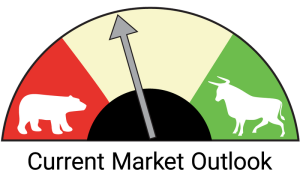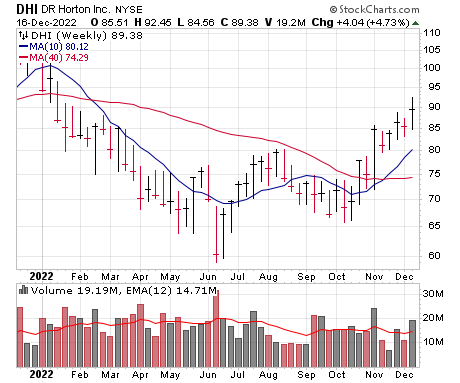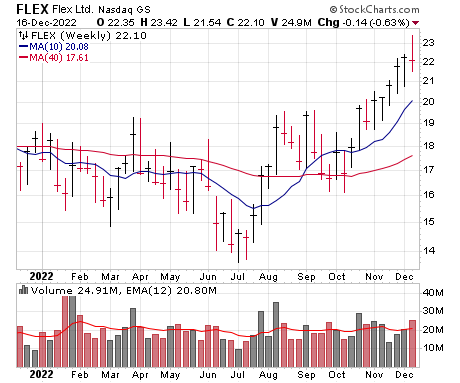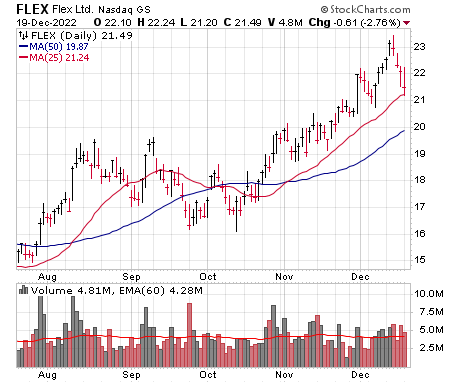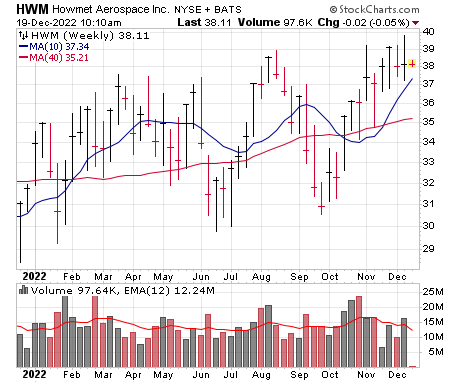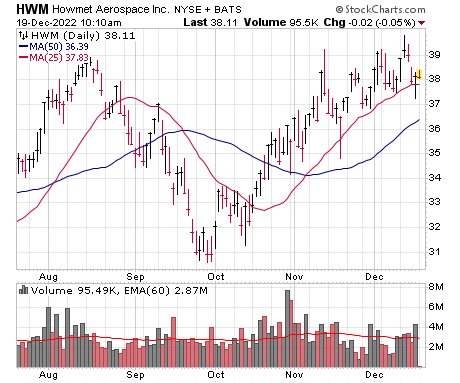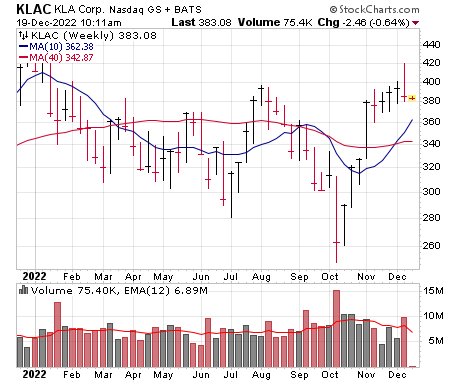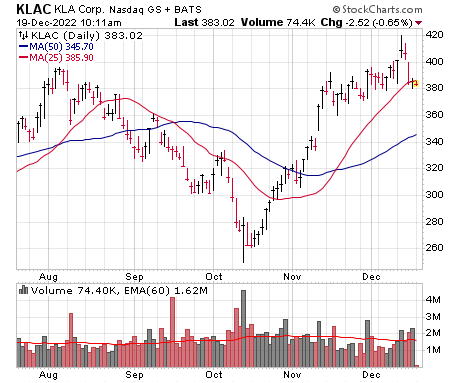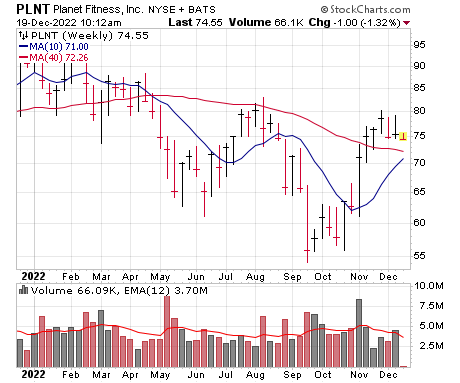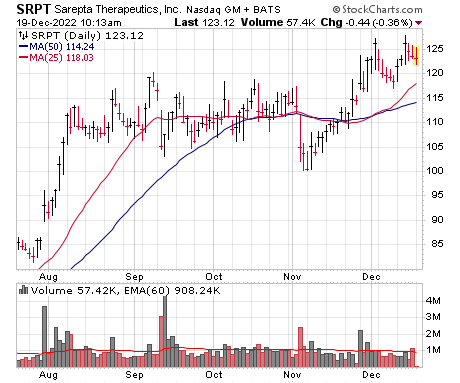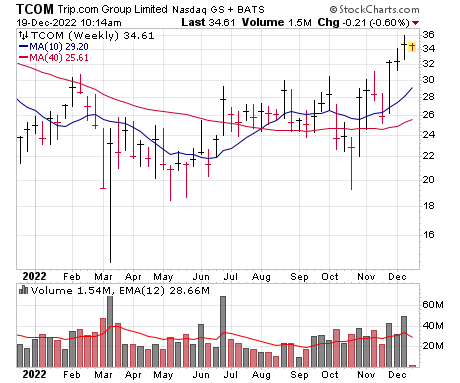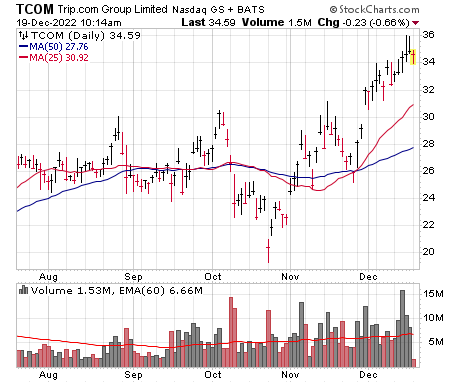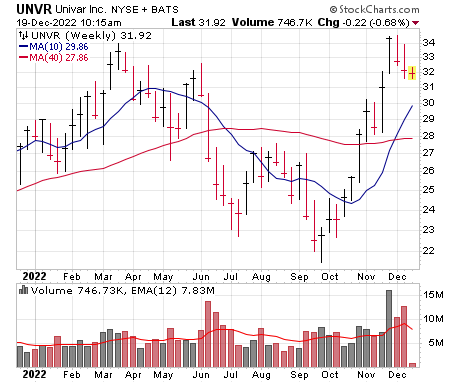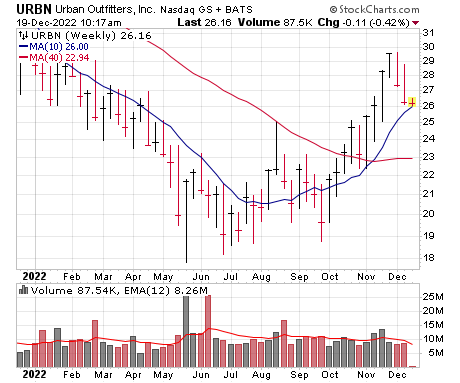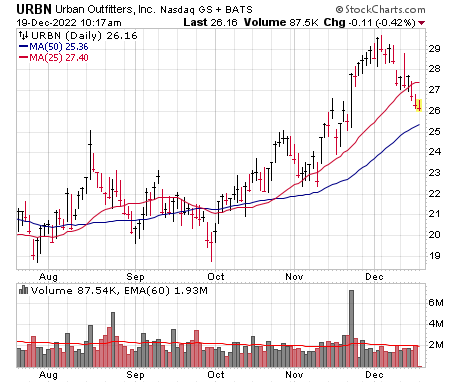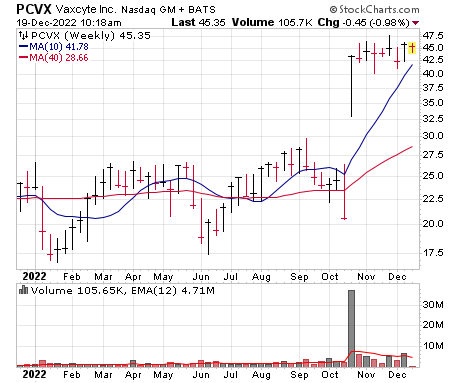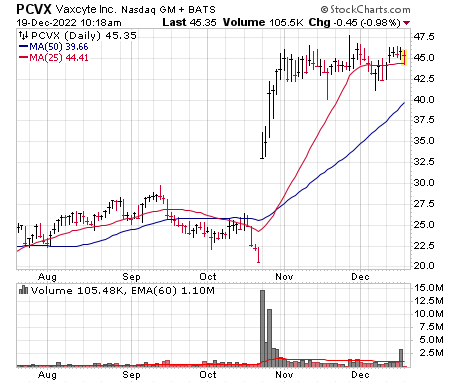Another Round of Selling
First, a housekeeping note: With Santa coming in a few days, there will be no issue next Monday nor Movers & Shakers update later this week—one of our two weeks “off” from Top Ten all year. However, we will send a “full” update next Tuesday (in place of the issue) to keep in touch, and we’ll be around if you have any questions. Merry Christmas and Happy Holidays!
As for the market, the post-Fed action was clearly a downer and is threatening to reverse the minor positives that had popped up in recent weeks—the most important of which is the intermediate-term trend, the lone positive major piece of top-down evidence, and that looks to be turning down after holding up well. Now, to this point, we will say many individual stocks have bent but haven’t broken, so if the selling pressures ease, there will be still be a good number of setups should the buyers actually show up. But clearly, after stalling out for a bit and then selling off the past two weeks, the onus is once again on the bulls to step up and offer support. We’ll move our Market Monitor down to a level 4, and it could sink further should the bears keep at it.
The good news is we’re still finding many solid-looking charts, though they’re from all nooks and crannies of the market. Our Top Pick today is D.R. Horton (DHI), the biggest U.S. homebuilder, and the stock is in an uptrend despite the worries about the housing market. Aim to buy on dips.
| Price |
Stock 1
D.R. Horton (DHI) ★ Top Pick ★
Price | Buy Range | Loss Limit |
Why the Strength
We’re growth-oriented investors, but we’re also students of the market and relative strength, and we’re very intrigued with the action of homebuilding stocks and of D.R. Horton in particular, which is the largest homebuilder in the U.S., having a countrywide footprint that’s led to a continual gain in market share. (It accounted for about 6% of single family new home sales in 2013, but that’s risen to around 12% so far in 2022.) With mortgage rates having skyrocketed since the fall of 2021, business has begun to feel the effect; in the September quarter, sales (up 19%) and earnings (up 26%) did well, though forward-looking measures were worse, with new orders off 10% (in dollars) and backlog down 16%. Still, given the severity of the interest rate hikes (mortgage rates went from 2.5% to 7%), was actually better than feared. And now investors are looking ahead as long-term rates are actually falling—ironically, as the Fed tightens, bonds are turning bullish, with mortgage rates nosing below 6% in recent days. There’s little doubt business is likely to suffer in the quarters to come—for the fiscal year ending next September, Wall Street sees Horton’s earnings off nearly 40%! But the bottom line here is that all of that appears to have already been discounted; the stock is trading at just 9x those earnings estimates, which could prove conservative—and a modest dividend yield (1.1%) and share buyback program (share count down 3.4% from a year ago with more on the way) helps the cause, too. It’ll be news driven, but D.R. Horton seems like an interesting turnaround play. Earnings are due January 24.
Technical Analysis
DHI had a great run after the 2020 crash in two stages, first moving to new highs in August near 77, and after a multi-month rest, a push all the way to 107 in May 2021. That began the topping process, which then led to the bear market decline that took the stock down to 60 in June—but, despite all the Fed hikes and bad housing news since then, that was DHI’s bottom, with a higher low etched in October (near 66) and an emerging uptrend since then, with no desire to retreat even when the market has gotten hit. There is old overhead around here, so if you want in, aim for dips of a couple of points.
| Market Cap | $30.8B | EPS $ Annual (Sep) | ||
| Forward P/E | 9 | FY 2021 | 11.41 | |
| Current P/E | 5 | FY 2022 | 16.51 | |
| Annual Revenue | $33.5B | FY 2023e | 10.09 | |
| Profit Margin | 16.9% | FY 2024e | 10.10 | |
| Qtrly Rev | Qtrly Rev Growth | Qtrly EPS | Qtrly EPS Growth | |
| ($B) | (vs. yr-ago-qtr) | ($) | (vs. yr-ago-qtr) | |
| Latest qtr | 9.64 | 19% | 4.67 | 26% |
| One qtr ago | 8.79 | 21% | 4.67 | 53% |
| Two qtrs ago | 8.00 | 24% | 4.03 | 59% |
| Three qtrs ago | 7.05 | 19% | 3.17 | 48% |
Weekly Chart | Daily Chart |
Stock 2
Flex Ltd (FLEX)
Price | Buy Range | Loss Limit |
Why the Strength
Based in Singapore, Flex is a leading global supply chain and electronics manufacturer, offering components, circuit board fabrication, design and engineering services to some of the world’s biggest companies at one of the industry’s lowest costs. Combined with its exposure to high-growth end markets, then, it should have solid growth potential, and that’s been playing out. In fiscal Q2 (September quarter), total revenue grew 25% from a year ago and was up in five of the firm’s core businesses; Flex continued to see sustained strength in customer backlog across most end markets, buoyed by what the firm sees as favorable “secular tailwinds” and a big improvement in the supply-chain environment. Per-share earnings of 63 cents, meanwhile, beat estimates by 12 cents. Leading the charge is Flex’s solar business, NEXTracker, which provides market-leading, sun-tracking solutions at utility scale; it’s also where Flex sees a massive, multiyear growth runway. Revenue soared 40% and margins improved in Q2 for the solar segment, and the company expects the U.S. green energy bill will contribute to growth going ahead as clients are moving production back to the U.S. from overseas to take advantage of the bill’s tax credits. Another of Flex’s key segments is automotive, which grew 26% in Q2, thanks mainly to increasing light vehicle demand, while its electric vehicles (EV) operation is garnering ever more sales. (Flex has a burgeoning portfolio of designer EV products and is teaming with some of the world’s biggest automakers to improve battery life and connectivity for EVs.) On the ratings front, two major Wall Street banks recently upgraded the 2023 outlook for Flex (both have helped the stock), with steady earnings growth expected.
Technical Analysis
After hitting a multi-year peak at 20 almost two years ago, the wind came out of the sails for FLEX and the stock entered a protracted trading range. Shares bobbed and weaved but made little headway for a monotonous 22-month stretch. But strength returned in late October and by late November, the stock finally lifted above the long-term range. The latest retreat could go on a bit, but if you want in, we’re OK nibbling here or (preferably) on further weakness.
| Market Cap | $10.0B | EPS $ Annual (Mar) | ||
| Forward P/E | 10 | FY 2021 | 1.57 | |
| Current P/E | 10 | FY 2022 | 1.96 | |
| Annual Revenue | $28.6B | FY 2023e | 2.28 | |
| Profit Margin | 3.7% | FY 2024e | 2.42 | |
| Qtrly Rev | Qtrly Rev Growth | Qtrly EPS | Qtrly EPS Growth | |
| ($B) | (vs. yr-ago-qtr) | ($) | (vs. yr-ago-qtr) | |
| Latest qtr | 7.77 | 25% | 0.63 | 31% |
| One qtr ago | 7.35 | 16% | 0.54 | 17% |
| Two qtrs ago | 6.85 | 9% | 0.52 | 6% |
| Three qtrs ago | 6.62 | -2% | 0.50 | 2% |
Weekly Chart | Daily Chart |
Stock 3
Howmet Aerospace (HWM)
Price | Buy Range | Loss Limit |
Why the Strength
Back in April 2020, Arconic (which itself used to be part of Alcoa) split into two pieces—one was the more commodity-based rolled products business (still called Arconic, symbol ARNC), but the other piece focused on engineered products and forgings for the aerospace and transport industry … and changed its name to Howmet, which now has a $15 billion market cap and is a big supplier in the aerospace sector, though it does business in commercial transportation and industrial areas as well. Howmet offers engine products (its largest segment; things like airfoils and rolled rings for engines and gas turbines), fastening systems (latches, bearings, fluid fittings, etc.), engineered structures (titanium forgings, machining services for airframes and wings) and forged wheels (aluminum wheels for trucks, buses and the like). There is competition, but Howmet’s offerings are often niche and it has a leadership position—the real driver here are industry trends, and on that front there’s plenty of good news, with travel demand back to pre-pandemic levels in the U.S.—and the hope is that lagging demand in Asia will reverse as their Covid policies ease. All in all, the writing is on the wall for greater wide-body aircraft production in 2023 and beyond (production of the Boeing 787 should pick up and be a driver), which means Howmet’s outlook is bright. In Q3, sales and earnings continued their solid growth path, and analysts see 10% sales growth and 24% earnings (and free cash flow) growth next year. A token dividend (0.4% yield) and active share buyback program (share count down 3.3% from a year ago) are also positives. It’s not sexy, but Howmet offers steady growth thanks to industry tailwinds.
Technical Analysis
HWM isn’t super powerful here, but it’s testing the high end of its multi-year range. In fact, the stock peaked in June 2021 near 36 and has nosed higher a few times since then—38 in March of this year, 39 in August and now near 40 in recent days. All told, we think it looks like a decent risk-reward on this pullback: A nibble on the latest dip with a stop in the mid 30s makes sense, and possibly adding on a burst over 40 (if the market is acting better).
| Market Cap | $15.8B | EPS $ Annual (Dec) | ||
| Forward P/E | 22 | FY 2020 | 0.80 | |
| Current P/E | 29 | FY 2021 | 1.01 | |
| Annual Revenue | $5.43B | FY 2022e | 1.40 | |
| Profit Margin | 10.6% | FY 2023e | 1.73 | |
| Qtrly Rev | Qtrly Rev Growth | Qtrly EPS | Qtrly EPS Growth | |
| ($B) | (vs. yr-ago-qtr) | ($) | (vs. yr-ago-qtr) | |
| Latest qtr | 1.43 | 12% | 0.36 | 33% |
| One qtr ago | 1.39 | 17% | 0.35 | 59% |
| Two qtrs ago | 1.32 | 10% | 0.31 | 41% |
| Three qtrs ago | 1.29 | 4% | 0.30 | 43% |
Weekly Chart | Daily Chart |
Stock 4
KLA Corp. (KLAC)
Price | Buy Range | Loss Limit |
Why the Strength
The CHIPS Act passed by Congress earlier this year is expected to reverse a multi-decade decline in the U.S. semiconductor production by providing billions in funding and tax credits to chips made here in the U.S. This looks to be a boon to the industry, and it’s just one of the reasons for the strength behind KLA, a provider of semiconductor metrology equipment used by chip makers to test wafers for imperfections after the manufacturing process. KLA leads the inspection space of the industry with a 55% market share, and with the federal government recently imposing restrictions against certain types of semiconductor sales to China, the company should benefit—particularly in the high-growth area of process control solutions, which test devices in a variety of ways and provide feedback for clients. As the memory industry moves increasingly to smaller, next-generation devices, KLA is capturing a bigger share of the market as these devices will need better measurement and inspection technologies. The company’s customer base and sales continue to expand: In the September quarter, revenue of $2.7 billion grew 31% from a year ago, driven by patterning systems sales (up 67%), while per-share earnings of $7.06 beat estimates by 84 cents. KLA also reported strength in its SPTS Technologies segment (which provides advanced packaging and LED solutions), as well as a 16% jump in services revenue. The firm is also boosting its capital returns, with a 1.3% yielding dividend and with an active share buyback program that’s shaved the share count by 7% year-on-year. Looking ahead, Wall Street sees 20%-ish top- and bottom-line growth in the current quarter and solid growth into the middle of next year.
Technical Analysis
This year has witnessed a cooling off phase for semiconductor stocks, and KLAC was no exception. The stock peaked in January just above 450 and, except for a brief summer rally, spent nine months churning lower to its nadir under 260 in October. However, that looks to be a shakeout now, with KLAC surging from its low to 380 in just four weeks, and since then, it’s held those gains despite the market’s action. We’re OK nibbling here with a stop a bit under 350.
| Market Cap | $54.7B | EPS $ Annual (Jun) | ||
| Forward P/E | 16 | FY 2021 | 14.55 | |
| Current P/E | 16 | FY 2022 | 21.15 | |
| Annual Revenue | $9.85B | FY 2023e | 24.62 | |
| Profit Margin | 36.9% | FY 2024e | 17.67 | |
| Qtrly Rev | Qtrly Rev Growth | Qtrly EPS | Qtrly EPS Growth | |
| ($B) | (vs. yr-ago-qtr) | ($) | (vs. yr-ago-qtr) | |
| Latest qtr | 2.72 | 31% | 7.06 | 52% |
| One qtr ago | 2.49 | 29% | 5.81 | 31% |
| Two qtrs ago | 2.29 | 27% | 5.13 | 33% |
| Three qtrs ago | 2.35 | 43% | 5.59 | 73% |
Weekly Chart | Daily Chart |
Stock 5
Planet Fitness (PLNT)
Price | Buy Range | Loss Limit |
Why the Strength
Planet Fitness was in the midst of a great growth phase until 2020 when the pandemic crushed business, but the firm hung in there, and now the story is back on track. The story here is simple and powerful: Planet Fitness is really the only game in town when it comes to a nationwide gym, with its franchisees (95% of stores are franchised) offering a good, non-musclehead experience for a reasonable price (as low as $10 per month, though most pay in the low $20s, which allows them to visit any location). And as opposed to many workout fads out there, it’s been a hit, with the firm accounting for 87% of the industry’s member growth from 2011-2019, and now that the pandemic has wreaked havoc on the industry (25% of the industry permanently closed, even as Planet has expanded), the firm is taking even more share, especially among the youngest demographics—and that says nothing of the 80% of people that don’t belong to any gym. Throw in the cookie-cutter aspect of the story (2,353 locations at the end of September, up 29 from the quarter before; should ultimately be more than 4,000 in the U.S. with more overseas) and there’s great potential going forward: In Q3, sales rose 58% from a year ago (partly pandemic affected), same-store sales rose a solid 8.2% (a third of that was from price hikes) and EBITDA was up 52%. Meanwhile, membership totaled 16.6 million, up from 15.2 million at the start of the year and up from 14.4 million at the end of 2019, before the virus. And the top brass sees much more growth ahead—at its November analyst day, it’s looking for low/mid-teens revenue growth and high-teens EBITDA growth annually for the next three years. This is still a good story.
Technical Analysis
Interestingly, even after its pandemic crash, PLNT returned to its highs in early 2021 and again in late 2021, but could never get going—and then the bear market dragged the stock down about 45% to its low in September of this year. But the Q3 reaction was solid, with PLNT running back to resistance near 80, and shares have held up well for the past couple of weeks despite the market’s action. It’s aggressive, but we’re OK with a small nibble here and a stop under the 50-day line, with the idea of averaging up if the market improves and this stock punches through 80.
| Market Cap | $6.80B | EPS $ Annual (Dec) | ||
| Forward P/E | 36 | FY 2020 | 0.04 | |
| Current P/E | 55 | FY 2021 | 0.82 | |
| Annual Revenue | $839M | FY 2022e | 1.59 | |
| Profit Margin | 15.6% | FY 2023e | 2.08 | |
| Qtrly Rev | Qtrly Rev Growth | Qtrly EPS | Qtrly EPS Growth | |
| ($M) | (vs. yr-ago-qtr) | ($) | (vs. yr-ago-qtr) | |
| Latest qtr | 244 | 58% | 0.42 | 68% |
| One qtr ago | 224 | 64% | 0.38 | 81% |
| Two qtrs ago | 187 | 67% | 0.34 | 240% |
| Three qtrs ago | 184 | 37% | 0.26 | 53% |
Weekly Chart | Daily Chart |
Stock 6
Sarepta Therapeutics (SRPT)
Price | Buy Range | Loss Limit |
Why the Strength
Sarepta’s application for an accelerated approval of its Duchenne Muscular Dystrophy (DMD) treatment was accepted by the FDA, with the agency setting an action date of May 29. It’s another step forward for the potential blockbuster treatment, SRP-9001, which would be the first gene therapy for Duchenne, which afflicts one in every 3,500 to 4,000 boys. DMD is diagnosed around the age of four, with muscle deterioration meaning patients need a wheelchair by 12, with their lifespan limited to 35 to 40 years. Many think an approved Duchenne genetic treatment has the potential to be a $4 billion market. Sarepta already has three injectable treatments that about one-third of DMD patients can take to improve their conditions. They will help the company generate between $905 and $920 million in revenue this year, a 30%-ish rise over 2021. If approved, SRP-9001 would be for patients in early stages of Duchenne, 4 to 7 years old, an age range that clinical studies show effectiveness in improving ambulatory ability. The treatment delivers to muscle a gene that codes as a functional form of dystrophin, a protein that acts like a shock absorber for muscle, which DMD sufferers lack. Sarepta is preparing for approval and gearing up production for SRP-9001, which has a two-year shelf life, and planning 50 sites to treat the bulk of DMD patients. The company also has an agreement in which pharma giant Roche will market the drug outside the U.S. Long-term, Sarepta has some three dozen other treatments in development for Duchene, as well as clinical trials to treat limb girdle muscular dystrophies (LMGD) and early-stage efforts aimed at multiple sclerosis and about dozen other similar afflictions. The bottom line is deep in the red, but analysts see sales up another 30% or so next year.
Technical Analysis
SRPT got off its knees starting in June, with positive clinical data in August adding an extra spark; shares motored to 114 initially and then up to 120 in September. The stock did digest after that, but did so in a resilient manner, giving up little ground even as the market caved in. The shakeout to 100 in early November was the low, and since then SRPT has nosed to new recovery highs. We like the action, but given the environment, we’ll set our buy range lower if you want in.
| Market Cap | $10.9B | EPS $ Annual (Dec) | ||
| Forward P/E | N/A | FY 2020 | -5.68 | |
| Current P/E | N/A | FY 2021 | -3.80 | |
| Annual Revenue | $877M | FY 2022e | -8.15 | |
| Profit Margin | N/A | FY 2023e | -4.92 | |
| Qtrly Rev | Qtrly Rev Growth | Qtrly EPS | Qtrly EPS Growth | |
| ($M) | (vs. yr-ago-qtr) | ($) | (vs. yr-ago-qtr) | |
| Latest qtr | 230 | 22% | -0.80 | N/A |
| One qtr ago | 234 | 42% | -1.18 | N/A |
| Two qtrs ago | 211 | 43% | -0.56 | N/A |
| Three qtrs ago | 202 | 39% | -0.77 | N/A |
Weekly Chart | Daily Chart |
Stock 7
Trip.com (TCOM)
Price | Buy Range | Loss Limit |
Why the Strength
China is setting up as a potential follow-on play to the post-vaccine rally here in the U.S. two years ago, and one beneficiary should be Trip.com as China shifts away from its Covid-zero policy, travel to the region is expected to strongly rebound in 2023. The international travel booking website offers customers deals in over 1.2 million hotels across more than 200 countries, but China is its most important market. That country’s accelerated easing of Covid strictures is a reason why a major Wall Street bank upgraded Trip.com last week based on “a likely faster-than-expected outbound travel recovery,” along with “continued momentum” in other foreign markets. Another reason for the optimism was the Q3 report released last Wednesday, which showed a consensus-beating 17% revenue spike from a year ago, to $969 million, plus EPS of 22 cents that beat estimates by four cents. Trip.com noted that China’s domestic hotel bookings in Q3 showed “positive growth” in recent months and have almost fully recovered to pre-pandemic levels, while the ending of Covid restrictions lays a “solid foundation” for a domestic travel rebound as well as the recovery of cross-border travel. Beyond China, the company’s international markets are doing great, with Q3 hotel bookings up 45% versus 2019, having topped the 2019 level for three straight quarters. Asia region travel, meanwhile, is accelerating thanks to the lifting of quarantine measures and the re-opening of borders; long-haul travel demand rapidly increased (up 130% from Q2), reflecting rising travel interest globally. All in all, Trip.com is poised to see its bottom line rip higher in 2023.
Technical Analysis
TCOM hit a major peak at 45 in March 2021 before entering a prolonged slide that lasted for a full year, lopping two-thirds off the stock’s price. From the March low at 15, TCOM popped 10 points higher right quick, but was mostly stuck in a holding pattern between 20 and 30 for the next eight months. A shakeout in October briefly pushed the stock below the 40-week line, but it snapped right back, and after another two-week wobble, shares have roared to new yearly highs. Dips of a couple of points would be tempting.
| Market Cap | $22.6B | EPS $ Annual (Dec) | ||
| Forward P/E | 33 | FY 2020 | -0.23 | |
| Current P/E | 144 | FY 2021 | 0.33 | |
| Annual Revenue | $2.95B | FY 2022e | 0.15 | |
| Profit Margin | 15.0% | FY 2023e | 1.05 | |
| Qtrly Rev | Qtrly Rev Growth | Qtrly EPS | Qtrly EPS Growth | |
| ($M) | (vs. yr-ago-qtr) | ($) | (vs. yr-ago-qtr) | |
| Latest qtr | 969 | 17% | 0.22 | 69% |
| One qtr ago | 600 | -34% | -0.05 | N/A |
| Two qtrs ago | 648 | 3% | -0.01 | N/A |
| Three qtrs ago | 737 | -3% | 0.08 | -70% |
Weekly Chart | Daily Chart |
Stock 8
Univar (UNVR)
Price | Buy Range | Loss Limit |
Why the Strength
Univar is the world’s second-largest distributor of commodity and specialty chemicals, serving customers across a wide range of industries. Its business involves buying chemicals from large producers and repackaging them for smaller customers while providing logistics services, too. Univar’s broad chemical portfolio and customer profile have allowed it to maintain stable growth in recent years despite some cyclical end markets, and much of its business is concentrated in the U.S. These attributes have served to attract the interest of German-based Brenntag, the world’s number-one chemical distributor. Univar recently confirmed it’s in preliminary discussions with its rival for a takeover, prompting a major Wall Street institution to raise its share price outlook for Univar. For Brenntag, Univar presents an opportunity to reduce its reliance on volatile European chemical markets, which are being hurt by soaring gas prices, with the added bonus of Univar’s own 2019 acquisition of Nexeo Solutions—another major global chemical distributor. (An activist investor is also speaking up, which adds to the shakeup potential.) On the financial front, Univar beat Q3 revenue estimates and posted sales of almost $3 billion, up 20% from a year ago, with per-share earnings of 84 cents surprising by 11%. The results were driven by “resilient” performance across its key segments, with the life sciences and pharmaceutical segment showing particularly “robust” share gains, along with “resilient growth” in the services channel. Management said the firm is on track to deliver record results for full-year 2022, guiding for adjusted EBITDA of just over $1 billion (up 25% if realized). Meanwhile, full-year free cash flow is expected to more than double to around $400 million, and Univar expects to generate some $1.5 billion in free cash flow from 2023 to 2025. It’s obviously a special situation, but we think the market and other industry players are realizing shares (11x 2023 estimates) are undervalued.
Technical Analysis
UNVR was in the doldrums between late March and late September, dropping 37% over that half-year stretch. The nadir was reached at 22, and the stock completely changed character right after, surging eight of the next 10 weeks to get right back to its prior high near 34. Shares did get hit a bit with the market in recent days, but dipped “only” to the 25-day line. If you want in, we think doing so here or on further dips is a decent risk-reward trade.
| Market Cap | $5.24B | EPS $ Annual (Dec) | ||
| Forward P/E | 11 | FY 2020 | 1.32 | |
| Current P/E | 9 | FY 2021 | 2.22 | |
| Annual Revenue | $11.4B | FY 2022e | 3.40 | |
| Profit Margin | 4.7% | FY 2023e | 2.96 | |
| Qtrly Rev | Qtrly Rev Growth | Qtrly EPS | Qtrly EPS Growth | |
| ($B) | (vs. yr-ago-qtr) | ($) | (vs. yr-ago-qtr) | |
| Latest qtr | 2.98 | 20% | 0.84 | 35% |
| One qtr ago | 3.02 | 26% | 1.00 | 75% |
| Two qtrs ago | 2.88 | 34% | 1.07 | 149% |
| Three qtrs ago | 2.50 | 23% | 0.60 | 76% |
Weekly Chart | Daily Chart |
Stock 9
Urban Outfitters (URBN)
Price | Buy Range | Loss Limit |
Why the Strength
Despite growing worries about a recession, the consumer remains strong: U.S. retail sales during last month’s Cyber Monday event increased 2% from last year—and a whopping 20% compared to pre-pandemic 2019—in turn lifting the outlook for Urban Outfitters. The lifestyle retailer specializes in fashion apparel, footwear and accessories for younger adults, and its pivot toward a digital sales strategy in recent years has paid off. Of course, growth here isn’t anything to write home about—Q3 sales increased 4% to a record $1.2 billion, driven by retail comp sales that were up the same amount. One growth driver was Urban’s subscription-based premium clothing rental business, dubbed Nuuly, which was particularly strong in Q3, posting a head-turning 170% sales increase and contributing to the overall retail segment growth. (Urban attributed Nuuly’s “robust” sales to a 37% lift in subscribers, exceeding 120,000 for the first time.) The company noted that customers of its other brands—Anthropologie, Free People and FP Movement—have been spending despite the inflationary environment, driving record sales in two of the three brands. Looking ahead, management said leaner inventories, a “precipitous” drop in supply-chain costs in the last six months and an improvement in speed-to-market capabilities should combine to deliver lower markdown rates while increasing profitability. The company also indicated that early holiday trends remain positive for the Free People Group, and it sees Urban’s retail segment performance looking similar in Q4 to the third quarter. Net-net, analysts see earnings bottoming out this year and rebounding 25% in 2023 to its second highest level in at least the past seven years.
Technical Analysis
URBN’s post-crash rally topped out in March 2021, with the bear taking hold in November, causing shares to slide persistently to 18 in May, more than 55% from its peak. But then the bottoming process began, with URBN finding support in the 20 area in June, July and again in September before rallying, with a persistent, accelerating advance to nearly 30 before pulling back. We’ll set our buy range up a bit, thinking a rally from this pullback near the 50-day line could lead to a run.
| Market Cap | $2.42B | EPS $ Annual (Jan) | ||
| Forward P/E | 12 | FY 2021 | 0.02 | |
| Current P/E | 15 | FY 2022 | 3.13 | |
| Annual Revenue | $4.73B | FY 2023e | 1.73 | |
| Profit Margin | 3.2% | FY 2024e | 2.17 | |
| Qtrly Rev | Qtrly Rev Growth | Qtrly EPS | Qtrly EPS Growth | |
| ($B) | (vs. yr-ago-qtr) | ($) | (vs. yr-ago-qtr) | |
| Latest qtr | 1.17 | 4% | 0.40 | -55% |
| One qtr ago | 1.18 | 2% | 0.64 | -50% |
| Two qtrs ago | 1.05 | 13% | 0.33 | -39% |
| Three qtrs ago | 1.33 | 22% | 0.41 | 37% |
Weekly Chart | Daily Chart |
Stock 10
Vaxcyte (PCVX)
Price | Buy Range | Loss Limit |
Why the Strength
Vaxcyte focuses on developing vaccines against bacterial diseases. It’s a clinical-stage company with promising treatments for pneumococcal diseases, a series of infections that can affect the ears, sinuses and the bloodstream. It has a potential best-in-class pneumococcal conjugate vaccine (PCV) in VAX-24, which is in Phase II trials with a Fast Track designation already and management pursuing a Breakthrough Therapy Designation. The company also has a follow-on candidate in preclinical study called VAX-XP, which is designed to provide coverage for 95% of pneumococcal diseases (PD) circulating the U.S. adult population. In November, management said top-line proof-of-concept data suggests that VAX-XP could exceed the current standard-of-care in the market. The PCV market is well-defined: It’s a $7 billion sector dominated by Prevnar, a treatment from Merck. But the market is in need of new drugs. The PCVs on the market appear to be hitting their limits of effectiveness, with drug chemistry unable to be made more effective in the short term without weakening long-term immunity in patients. In addition, the PCV type covered by Prevnar isn’t as prevalent anymore. Vaxcyte believes it can overcome such limitations by combining advanced chemistry with modern synthetic techniques. If it can succeed, Vaxcyte’s treatments promise to get to market at a time when the Centers for Disease Control are considering PCV expansion by recommending universal vaccination in U.S. adults – that would nearly double the market to $13 billion a year. Vaxcyte has more than $1 billion in cash thanks to an October stock offering, giving the firm time to get to market and absorb the current period of no revenue and big losses, $57.9 million in the most recent quarter. It’s an interesting speculation.
Technical Analysis
Positive top-line data for VAX-XP broke PCVX out of a 22-month long range of 17 to 28 in October. Shares gapped more than 50% higher on the news and continued higher for a few days, reaching the 45 area soon after. And, instead of keeling over with the market, PCVX has stood firm, with a couple of shakeouts into the 41 range but quick snap backs each time. It’s obviously a roll of the dice, but nibbling on further dips would be intriguing.
| Market Cap | $3.62B | EPS $ Annual (Dec) | ||
| Forward P/E | N/A | FY 2020 | -1.76 | |
| Current P/E | N/A | FY 2021 | -1.93 | |
| Annual Revenue | Nil | FY 2022e | -3.24 | |
| Profit Margin | N/A | FY 2023e | -3.04 | |
| Qtrly Rev | Qtrly Rev Growth | Qtrly EPS | Qtrly EPS Growth | |
| ($B) | (vs. yr-ago-qtr) | ($) | (vs. yr-ago-qtr) | |
| Latest qtr | N/M | N/M | -0.93 | N/A |
| One qtr ago | N/M | N/M | -0.80 | N/A |
| Two qtrs ago | N/M | N/M | -0.68 | N/A |
| Three qtrs ago | N/M | N/M | -0.55 | N/A |
Weekly Chart | Daily Chart |
Previously Recommended Stocks
The next Cabot Top Ten Trader issue will be published on January 3, 2023.

